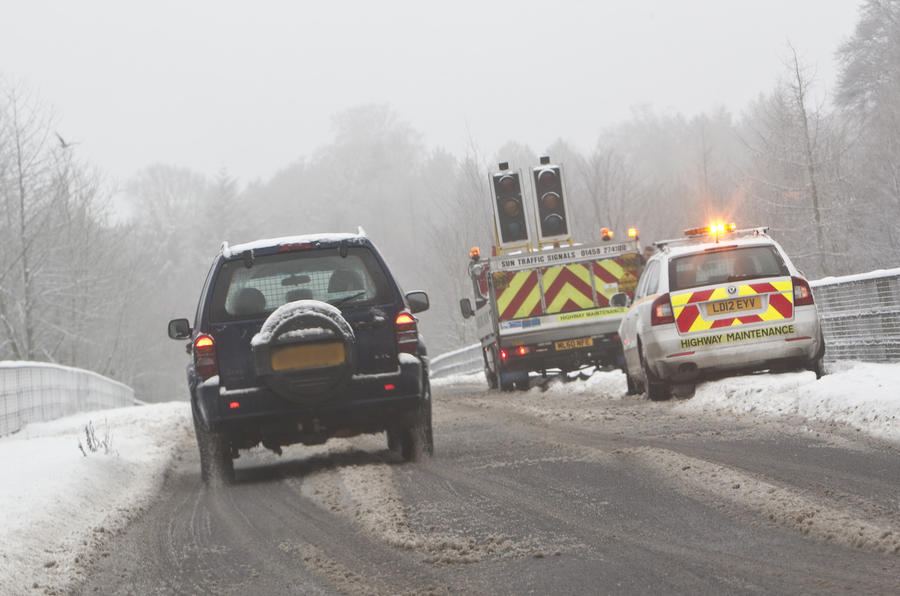You can see the air of superiority on the faces of just about all drivers of 4WD vehicles in this weather, be they Range Rover or Suzuki Jimny drivers. And in one specific sense the owners of 4WDs are right to feel better endowed to deal with the conditions than the rest of us.
Because any four wheel-drive vehicle does indeed generate better traction than its two wheel-drive equivalent, on all surfaces and in all conditions but never more so than when it snows. But more cornering grip outright? Not necessarily.
How so? Lateral grip, in other words the sort that your vehicle generates when it is cornering, is completely different from traction, yet more often than not the average 4WD driver fails, I suspect, to realise the difference between the two.
Bottom line; on any surface but especially on snow, you can get going and you can develop far better traction and initial acceleration in a 4WD than you can in a 2WD vehicle, but when you reach a corner you will NOT be able to get round it any faster. Which means you are every bit as likely to fall off the road once you’ve got going in a 4WD than you are in a 2WD.
This is because, despite its better traction, a 4WD vehicle develops no more lateral grip than its 2WD equivalent once you are in a steady state of cornering – even though it will generate more traction on the way out.
What does make a massive difference to lateral grip in conditions such as we have now are the tyres you choose to drive on, and the tyres that the average heavy duty 4WD – such as a Land Rover – comes fitted with as standard compared with a more conventional road car. Winter tyres, or better still proper off-road tyres like those of a fully tooled-up Land Rover, are a hugely more significant factor in snow than the ability to send drive to all four wheels, in my opinion.
I’d even argue that a big, heavy, luxury 4WD that’s riding on big, fat summer tyres is actually a far less effective tool overall in snow than a small 2WD car fitted with winter tyres. Not merely because it won’t generate as much grip in corners than the winter-tyred 2WD car will, but because it will take MUCH longer to stop in as well.
So, the next time you see that mildly smug expression on the face of the person driving the Range Rover that’s just blundered past you in the snow, believing that they’re invincible, just remember; in reality they’re just as likely to fall off at the next corner as you. And at 2.5 tonnes they’ll be far less able to stop for something unpredictable that may be lurking half way round that next corner. And their repair bill will be 20 times higher than yours.






Join the debate
Add your comment
I have a low-quality video of
It is possible to survive
It is possible to survive with fwd and winter tyres in the north, but I would avoid the DSG, it makes hard work of hill starts, 1:4 is not really possible on ice (once you get it going it goes but not you'll need to start on a shalllower gradient, saying that is no different to our previous 4x4 on all season tyres), 1:5 is about the limit, also the winter tyres are worth it for the ability to stop when somebody slides out in front of you. I also feel safer sitting lower down when the conditions are slippy, a slide seems to be alot quicker to correct in a hatch rather than an SUV.
hotspot software
The Hotspot VM is a collection of techniques, the most significant of which is called "adaptive optimization." In fact, this technique gives Hotspot its name.http://www.antamedia.com/hotspot/
Time for a summary?
The Scandinavians here have made some really good and valid points. And a few others too.
To summerise:
Interestingly nobody has said anything about snow chains!
Also, my previous Subaru WRX PPP was terrible in snow. Tyres were too wide, and lacked any tread (Bridgestone RE070 - super grippy in the dry!). But I felt that the differential was too tight to allow the front and rear axles free spinning. Therefore when cornering they were in effect fighting each other with the result that rear lost out. Which was cool when I had to correct the slide when exiting a roundabout which resulted in me drifting perfectly towards the exit I wanted.